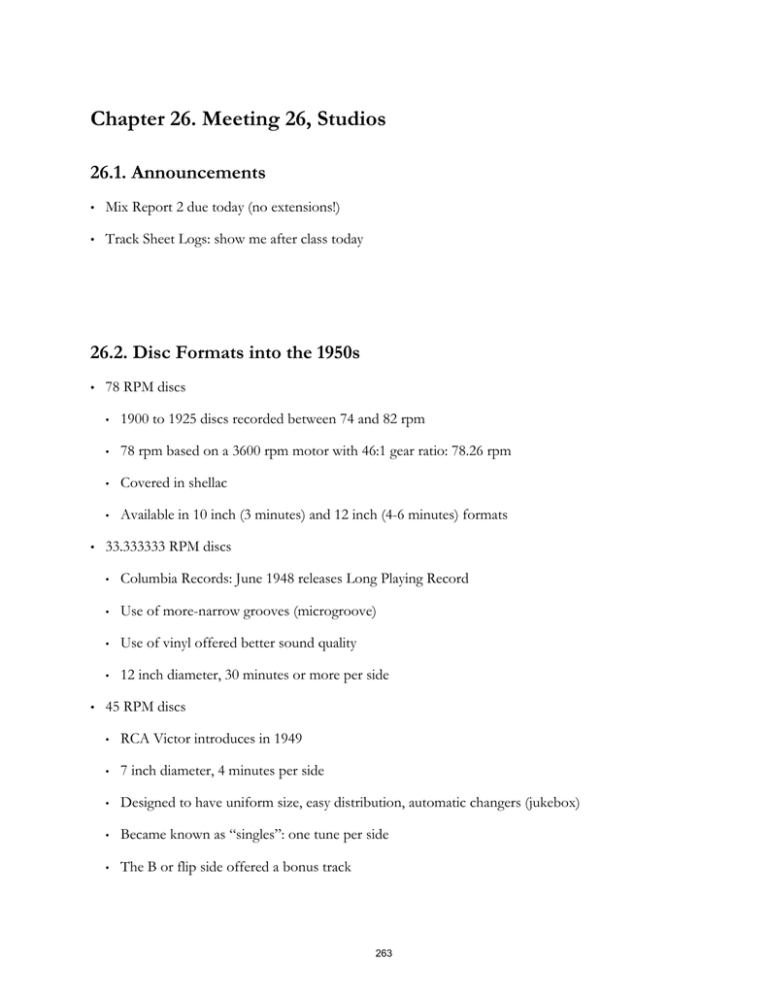
Chapter 26. Meeting 26, Studios
26.1. Announcements
•
Mix Report 2 due today (no extensions!)
•
Track Sheet Logs: show me after class today
26.2. Disc Formats into the 1950s
•
•
•
78 RPM discs
•
1900 to 1925 discs recorded between 74 and 82 rpm
•
78 rpm based on a 3600 rpm motor with 46:1 gear ratio: 78.26 rpm
•
Covered in shellac
•
Available in 10 inch (3 minutes) and 12 inch (4-6 minutes) formats
33.333333 RPM discs
•
Columbia Records: June 1948 releases Long Playing Record
•
Use of more-narrow grooves (microgroove)
•
Use of vinyl offered better sound quality
•
12 inch diameter, 30 minutes or more per side
45 RPM discs
•
RCA Victor introduces in 1949
•
7 inch diameter, 4 minutes per side
•
Designed to have uniform size, easy distribution, automatic changers (jukebox)
•
Became known as “singles”: one tune per side
•
The B or flip side offered a bonus track
263
•
Extended Play (EP) 45s achieved 7 minutes per side
26.3. Early Magnetic Recording Devices
•
1930s: Magnetophone (AEG, Germany)
•
1940s: Commercially developed in the late 1940s by American Jack Mullin with Bing Crosby
•
Reel to reel audio tape recording machines spread in 1950s with companies like Ampex
264
© Source unknown. All rights reserved. This content is excluded from our Creative
Commons license. For more information, see http://ocw.mit.edu/fairuse.
265
© Source unknown. All rights reserved. This content is excluded from our Creative
Commons license. For more information, see http://ocw.mit.edu/fairuse.
•
Multitrack recording on tape, pioneered by Les Paul, developed as early as 1954
26.4. Analog Audio Multitracks: Les Paul
•
1940s: Guitarist Les Paul (1915-) experiments with adding and bouncing tracks in direct to wax
disk recording
•
1948: produced “Lover (When You're Near Me)” album with this technique, combining up to 8
guitars
•
Modifies an Ampex Model 300 mono tape recorder to record multiple individual tracks
266
© Source unknown. All rights reserved. This content is excluded from our Creative
Commons license. For more information, see http://ocw.mit.edu/fairuse.
267
•
By 1953 develops first 8 track recorder
•
Employed different playback speeds of each track
•
In class listening: Les Paul and his wife (audio
26.5. Reading: Horning, From Polka to Punk: Growth of an
Independent Recording Studio, 1934-1977
•
Describe the trajectory of recording and mixing equipement used at the Cleveland Recording
Company.
•
Describe the trajectory of clients that recorded at Cleveland Recording Company.
•
What were some of Hamann’s technical achievements?
26.6. Tom Dowd: Recording Engineering Innovator
•
“Tom pushed those pots like a painter sorting colors. He turned microphone placement into an
art” (Atlatnic’s Jerry Wexler on Dowd; Horning 2002, p. 144)
•
Video clip: Tom Dowd: The Language of Music, Chapter 2 (00:02-01:16, 2:42-3:47, 4:10-5:08)
•
Video clip: Tom Dowd: The Language of Music, Chapter 7 (3:40-7:05)
26.7. Monitoring and Studios: Simultaneous Recording
•
To improve isolation during simultaneous recording, studios have multiple (isolation) rooms
(booths)
•
Permit visual contact (windows, video) and aural interconnections
•
Requires a monitor feed to be sent from the recording unit to each musician
•
Permits musical, expressive performances and great mix flexibility
26.8. Studio Design Examples
•
Sony/Tree’s Music Studio, Nashville
268
Courtesy of Russ Berger Design Group, Inc. Used with permission.
•
Paisley Park’s Studio A
© Paisley Park Studios. All rights reserved. This content is excluded from our Creative
Commons license. For more information, see http://ocw.mit.edu/fairuse.
•
Studio X, Seattle
269
6WXGLR;$OOULJKWVUHVHUYHG7KLVFRQWHQWLVH[FOXGHGIURPRXU&UHDWLYH
&RPPRQVOLFHQVH)RUPRUHLQIRUPDWLRQVHH KWWSRFZPLWHGXIDLUXVH
26.9. Monitoring and Studios: Non-Simultaneous Recording
•
For maximum isolation, can record each part (or section) separately and then overdub
•
Requires a monitor feed of previous tracks to be sent to each musician
•
Possible benefits using a consistent (or composed) tempo via a click track
•
Permits greatest mix flexibility, but sometimes challenging performance contexts
26.10. Headphone Monitoring with MOSS
•
From within the DAW, create auxiliary channels for each monitor channel
•
Use send controls on each channel to send to the appropriate aux channel
•
Route output of aux channels to physical outputs on the computer interface (RME)
•
Patch up to 8 monitor channels into HearBack Hub inputs
•
Distribute personal mixers via CAT-5 cables
270
© Hear Technologies. All rights reserved. This content is excluded from our Creative
Commons license. For more information, see http://ocw.mit.edu/fairuse.
26.11. Mix Report 2 Examples
•
?
271
MIT OpenCourseWare
http://ocw.mit.edu
21M.380 Music and Technology: Recording Techniques and Audio Production
Spring 2012
For information about citing these materials or our Terms of Use, visit: http://ocw.mit.edu/terms.




